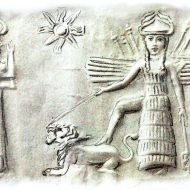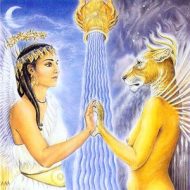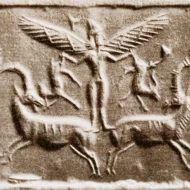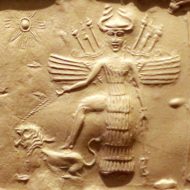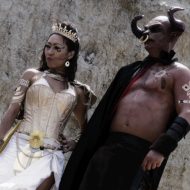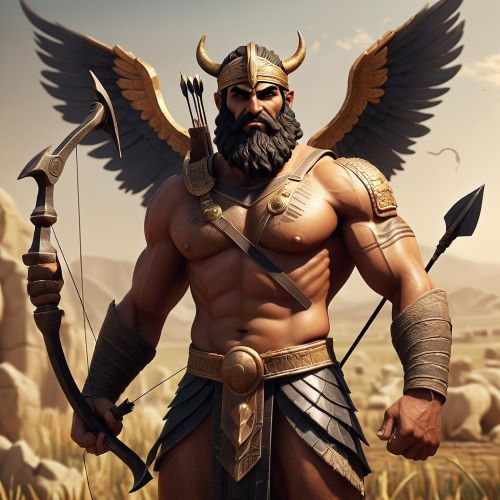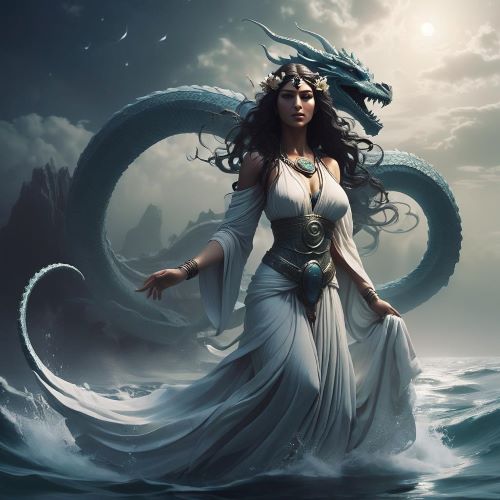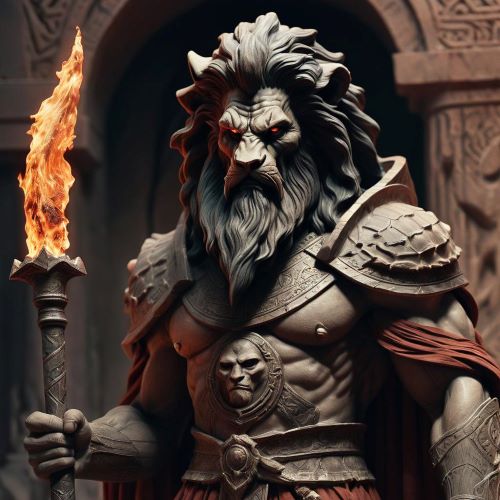Innana : Goddess of Love
Listen
At a glance
| Description | |
|---|---|
| Origin | Sumerian Mythology |
| Classification | Gods |
| Family Members | Utu (Brother), Ereshkigal (Sister), Dumuzid (Husband) |
| Region | Iraq |
| Associated With | Love, Sex, Fertility, War |
Innana
Introduction
Among the most significant goddesses of Mesopotamia was Inanna, who was also known as Ishtar. According to stories, she was most likely born around the 3rd millennium BCE and resided in Uruk, which was her primary city. There, she was depicted as the Lady of the Date Clusters.
It is clear that Inanna was more of a goddess of war, love, and sex than a great mother. She was also regarded as the goddess of the me (kingship, godship, sexual practices, marriage, and political power) which means that she was the equivalent of the great male deities in the Sumerian pantheon.
She was eventually regarded as a goddess by the Assyrians, Babylonians and Akkadians and was identified as Ishtar. She was also associated with various other notable individuals such as the Phoenician Astartes, the Greek Aphrodite, and the Hittite Sauska.
Innana was seen as the star of the evening and morning, and she was also associated with the Roman goddess Venus. Some believe that Inanna was the subject of a relief known as the Burney Relief, which dates back to the reign of Hammurab of Babylon. However, Ereshkigal her sister, is believed to be the goddess depicted in the statue.
Physical Traits
Inanna is often depicted riding a lion, which is a sign of her dominance over the king of beasts. In her role as a goddess of war, she is depicted wearing armor that is similar to that of a male warrior. She is also linked to Athena Nike, a Greek goddess. The most common symbol of Inanna was the eight-pointed star. There were also six-pointed stars, but their symbolic significance is not clear. Inanna’s ideogram was made with a twisted knot of reeds, which represented the doorwaypost of the storehouse which in turn meant abundance and plenty.
Family
The twin brother of Inanna was Utu, who was also known as Shamash in Babylonian mythology. In Sumerian literature, Utu and Inanna are often depicted as very close, and some authors have claimed that their relationship is incestuous. In her myth, Inanna refers to Ereshkigal as her older sister. However, the two goddesses rarely appeared together in god lists and were not included in the same category.
Dumuzid, who was regarded as Inanna’s husband, was often depicted as the god of shepherds. However, some believe that Inanna’s loyalty to him is suspect. In her descent into the underworld, Inanna grants the galla demons the power to abduct Dumuzid. Inanna was not typically depicted as having any offspring. However, in a story from the 3rd Dynasty of Ur, a warrior god known as Shara was referred to as her son.
Other names
Scholars believe that Ishtar and Inanna were initially unrelated. However, during the reign of Sargon, they were mistakenly combined and regarded as one goddess. Inanna’s name is said to have come from the Sumerian word nin-an-ak, which means “Lady of Heaven”. Some Assyriologists believe that Inanna was originally a Proto-Euphratean goddess. She was eventually accepted as a goddess by the Sumerians.
Powers and Abilities
The goddess Inanna was regarded as the goddess of love and warfare by the Sumerians. Unlike other gods, who had fixed roles and had limited domains, Inanna was seen as a moving target who constantly sought to gain more power than she was given. She was also depicted as a young and impetuous woman. Although she was regarded as the goddess of love, she was never seen as a mother or wife.
Inanna’s main temple was at Uruk, but throughout Mesopotamia, her shrines and temples were filled with sacred prostitutes who were either male or female. These individuals were believed to have been hired to ensure that the communities would continue to grow. Her clergy were also reportedly both male and female.
Modern Day Influence
In the ancient Sumer, Inanna was one of the oldest deities. She is listed as one of the seven divine powers, along with Enki, Enlil, Utu, Nanna, and Ninhursag. These seven were the basis for various characteristics of the gods that followed. Inanna inspired similar deities in other cultures.
Inanna was a different kind of goddess from the traditional one. She was an impulsive and conceited young woman who was kind and impulsive at the same time. The Sumerians were able to create a goddess who was regarded as feminine, which demonstrates their cultural understanding of the concept of femininity. In the Sumerians’ pantheon, there were several notable female deities, such as Ninkasi, Nisaba, Gula, Ninhursag, and Nanshe.
During the reign of Hammurabi of Babylon, many goddesses were replaced by gods. Inanna was adopted by the Neo-Assyrian and Assyrian empires as Ishtar, which was a goddess of sex and war. Unfortunately, other goddesses did not fare well.
Related Images
Frequently Asked Questions
Who is the god of Inanna?
Inanna is an ancient Mesopotamian goddess associated with love, war, and fertility. She was originally worshiped in Sumer and was known by the Akkadian Empire, Babylonians, and Assyrians as Ishtar.
What are Inanna's powers?
Inanna was also seen as the bright star of the morning and evening, Venus. She was the patron goddess of the Eanna temple at the city of Uruk, her early main cult center. As a goddess, Inanna would possess superhuman strength, durability, and other physical characteristics. She is immune to the effects of aging and conventional disease.
Who did Inanna love?
Inanna, the ancient Mesopotamian goddess of love, was married to the god Dumuzid, who was later known as Tammuz. Their relationship is celebrated in the poem “The Courtship of Inanna and Dumuzi”.
Who was Inanna killed by?
Inanna, the ancient Mesopotamian goddess, was not killed by another deity or person. Instead, she died during her descent into the underworld, which was ruled by her older sister, Ereshkigal.
Was Inanna good or bad?
Inanna, like many deities in ancient religions, embodies a complex mix of characteristics and cannot be simply categorized as “good” or “bad”. She was a powerful goddess associated with love, war, justice, political power, and several other domains.

